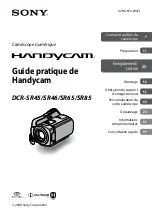
8
9
cleaning and replacing the eyecups
The eyecups (complete modules) can be removed from the binoculars for replacement or clean-
ing.
Turn the eyecup
(Fig. 1/2)
upwards to the stop, then unscrew it completely via the thread
(continue to turn in the same direction). After cleaning or replacement, turn the eyecup clockwise
to the lowest click stop position. Finally, place the eyecup onto the binoculars and screw on well
by turning it clockwise until it stops and tightens.
adjusting the interpupillary distance
Adjust the two barrels relative to each other about the central axis until you see one circular field
of vision when viewing with both eyes.
Focusing
The binoculars have a focusing knob
(Fig. 1/3)
and a diopter adjustment wheel
(Fig. 1/1)
.
To adjust, close your right eye and focus the image in the left barrel using the centre focusing
knob
(Fig. 1/3)
. Then close your left eye and, if necessary, adjust the focus in the right barrel using
the diopter adjustment wheel
(Fig. 1/1)
.
The diopter adjustment is provided with a scale with “+” and “–” and has an index point as a
reference point (setting the diopter adjustment for different users).
Note: Always use the same object to focus both images!
For subsequent focusing on varying distances, use only the focusing knob
(Fig. 1/3)
.
Mounting the carrying strap and the protective covers
The carrying strap, the eyepiece cap and the protective lens cap are supplied with the binoculars.
Attach the carrying strap to the eyelets provided on the binoculars, and mount the eyepiece cap
on the strap as shown in
Figs. 2, 3 and 5
.
The strap for the protective lens cap is attached directly (either right or left) to the protective
lens cap. To fasten on the device, use either the carrying strap or one of the two carrying strap
eyelets.
Note: Simply pass the carrying strap through the eyelets on the eyepiece cap. Before attaching
the carrying strap, as shown in
Fig. 3
, the strap length should be set at the desired length by
shortening or lengthening the strap.
Follow the same sequence for the opposite side. Some prefer to thread through the cap on both
sides, and some on only one.
use of the eyepiece cap
The eyepiece cap is kept on the eyecups. Remove the eyepiece cap with your index fingers before
using the binoculars.
use of the protective lens cap
The protective lens cap is kept on the eyecups. Remove the protective lens cap with your index
fingers before using the binoculars.
Mounting on a tripod
Binoculars from the CONQUEST HD series can be mounted on any commercial camera tripod
using the Carl Zeiss universal tripod adapter for binoculars.
The order numbers for Carl Zeiss tripods and the Binofix tripod adapter can be found under
Accessories for CONQUEST HD.
care and maintenance
The binoculars are provided with Carl Zeiss LotuTec
®
coating. The effective protective coating for
the lens surfaces noticeably reduces contamination of the lenses through a special smooth sur-
face and the combined beading effect. All types of contamination adhere less and can be quickly
and easily removed, smear-free. The LotuTec
®
coating is also durable and abrasion resistant.
We recommend using the Carl Zeiss lens cleaning cloth (included) to clean the surface of the
lenses. Even grease, fingerprints and dirt can be removed with no effort and without smears.
Do not wipe coarse dirt particles (e.g. sand) from the lenses; instead blow off or remove with a
fine brush. Other textiles, such as clothing or handkerchiefs can scratch the lenses and statically
charge them.
We recommend regular cleaning of the lens surfaces. Contamination, especially grease or
fingerprints, can attack the lens surfaces after a while. Dry storage and keeping the outer lens
surfaces well ventilated, especially in the tropics, helps to prevent a possible mould film forming
on the optics.







































